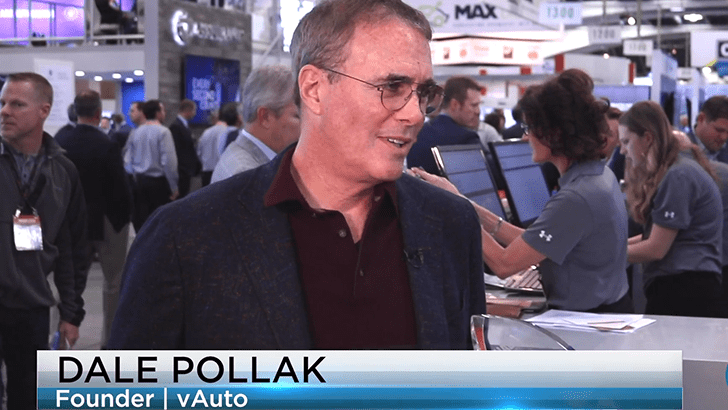At this year’s NADA Show in San Francisco, CBT News had the pleasure of sitting down with several prolific dealers, vendors, and industry specialists. One of those specialists was Dale Pollak, executive vice president at Cox Automotive and founder of vAuto. In today’s segment, Jim and Dale discussed how dealers can minimize margin compression by better managing and marketing their used car inventory.
For more coverage from the 2019 NADA Show, visit us here.
VIDEO TRANSCRIPT:
Jim Fitzpatrick: So Dale, welcome to CBT. So glad you took some time with us.
Dale Pollak: Thanks, Jim, always great to be with you.
Jim Fitzpatrick: Great. So, I’m holding in my hand right here, a beautiful award given to you by NADA. Says, “Awarded to Dale Pollak for coming to 50 years.” So talk to us a little bit about that.
Dale Pollak: So, I grew up in a car dealer family. My dad was a dealer and I was the youngest of four sons. And the deal was that my father would not take us to NADA until we turned ten.
Jim Fitzpatrick: Until you turned ten! You’d be able to absorb more at ten, I guess.
Dale Pollak: So, while we behaved reasonably well. So, I suffered the humility, year after year, of watching my brothers turn ten, go off to NADA. And they would call me from NADA and I remember, you could hear the sound of the quarters going into the telephone. And they would razz me about all the fun they were having.
All the trinkets they were collecting. So when I turned ten I was determined to go, and for one reason or another, I haven’t missed one yet.
Jim Fitzpatrick: That is incredible. Kudos to you and congratulations.
Dale Pollak: Thank you, thank you.
Jim Fitzpatrick: That’s actually a pretty cool thing that they did. So I’m going to put it right over here, so we can continue here. But, right now everybody that’s here, and there’s obviously thousands of people, thousands of dealers as there is every year. One of the top subjects, as it’s been for the last few years, is the talk of margin compression. It seems to be at the forefront of every dealer’s mind. They’re just really down in the dumps about not making enough money on the sale of these cars.
And I know that you guys work diligently at vAuto to help dealers navigate through that and find better ways to find more profit in their deals and in within their dealership. So talk to us about margin compression, and then some of the solutions that you’re coming up with.
Dale Pollak: Right. So, in my opinion, margin compression is the single biggest risk to a dealer’s profitability today. But something has happened, Jim, in the last two years. It’s like the market has hit a point of [influction 00:01:52]. Where maybe everybody’s got tools, everybody’s figured out that you need to price vehicles competitively. But something’s happened in the last two years, that I know objectively and empirically to be true. And that is that an average vehicle, take a listen to this, an average vehicle loses its ability to make a positive return on investment somewhere between 30 to 40 days.
Now, let me explain that. You might have a vehicle in your inventory that retails somewhere around 30 to 40 days, and it might show a front end gross profit. It might be small, but it will maybe show a front-end gross profit. But what you don’t see is that is actually a negative ROI transaction. Because once you pay a commission on that sale and you allocate the departmental expenses to it, it actually produces a negative ROI on the bottom line.
So for dealers today, they have to understand that math. And if they don’t understand the math, they’re working under an old assumption that if you just sell cars, you’ll make money. And a correlate to that is too many dealers today feel that the way to sell cars or sell more cars is to stock more cars. That used to be right, today it’s wrong.
Because think about it this way Jim, if you owned a fish market and you stocked more fish this week than you sold, what happens to that excess fish?
Jim Fitzpatrick: The fish goes rotten, that’s right.
Dale Pollak: Well, today, the financial reality, the math is, that if you stock more cars and you’re going to sell them 30 to 40 days, what happens to those excess cars? They will be a net ROI. So you have to understand the math, and you can’t fight the math.
Jim Fitzpatrick: So, in doing some research to develop ProfitTime, talk to us about Profit Time, and then we’ll get into the research behind it.
Dale Pollak: So, I think it’s fair to say, Jim, that I was here fifteen years ago with an idea and a new concept, a new product, called vAuto. And I believed at that time that we were gonna change the way dealers managed used vehicle inventory. And I think it’s fair to say we’ve had something to do with that having happened. And I stand here with you today, never ever believing I would say this again. But I’m telling you that with ProfitTime, we will change the way the industry manages used inventory.
And I’ll tell you why I say with the confidence that I have. Is that, with new technology and data processing, we actually discovered, discovered, that there’s a flaw in a basic assumption that is the premise of ever consequential decision made about a used vehicle. I’m talking about the decision about what car to buy, how much to pay for it, how to price it, how to re-price it, when to re-price it. Every decision of consequence that’s made today on a used vehicle is made on a flawed assumption.
What is the flawed assumption? It’s the assumption or the belief that the amount of time that you hold the car equates to the amount of profit a car holds. And what we proved is that more times than not, that’s incorrect. So, based on that wrong premise, dealers make decisions that are inefficient and suboptimal and cost them money.
So ProfitTime is a technology solution that shows every dealer every day the true profit potential of every vehicle. Now, that is a solution, but here’s really the big new part of it. It requires a new management approach. And to be quite honest with you, when I came up with this, a lot of people said to me, “Dale, you’re not really going to do that are you? You’re not really going to go out and say that, are you?”
Jim Fitzpatrick: I would imagine not. You’re totally breaking the mold.
Dale Pollak: Right. And we built a company, a successful company, on the principles of velocity. And my response is, “Yeah. We are absolutely going to do it.” Because if it’s the right thing to do, it’s the right thing to do. So here’s what ProfitTime will do, and here’s what it won’t do. Every day, every car, it will show you the true profit potential of that vehicle, regardless of what the calendar says it is.
Jim Fitzpatrick: Wow. That’s a whole new way to look at your inventory.
Dale Pollak: Here’s what it won’t do. It won’t make the tough decisions. And if you’re going to be successful with ProfitTime, you have to be prepared to make hard decisions and make them fast. On cars.
Jim Fitzpatrick: And what do you mean by that? Drill down a little bit, what’s a “hard decision”?
Dale Pollak: So, when you get a car in stock on day one, as dealers always do in large quantities, that holds little if any investment potential. Regardless of the calendar, you have to recognize her for what it is, which ProfitTime score will tell you. But then you have to say, “Okay, that car’s going to go today.” And here’s the problem. The calendar, the way we used to manage inventory-
Jim Fitzpatrick: They say no, we got 30 days before it’s an issue.
Dale Pollak: Exactly, relax. In reality, that car’s not going to get better, it’s going to get worse.
Jim Fitzpatrick: Right. We’re always in hunt of the if, come, maybe somewhere down the road that somebody might walk in and hit at their head and say, “Yeah, I’ll pay stupid money for that car.”
Dale Pollak: And it used to happen. It doesn’t happen anymore. So this is a very important point I want to get out there. I tell people that I’m 100% sure that ProfitTime is going to be the way we’re all manage inventory. But I will also say at any dealer, that it’s not right for a lot of dealers today. Reason being, is that if you’re not willing to make those hard decisions, make them fast, you shouldn’t expect any uplift from ProfitTime.
So, how do you determine whether a dealer is ready? Well, I have a simple test. Look at your inventory, and if you have more than 15% of your inventory over 60 days, you’re not ready. Because you know what that says? That says you’re not making any hard decisions.
Jim Fitzpatrick: That’s right. You’re just leaving it.
Dale Pollak: Right. Why would I expect you’d make a hard decision fast with ProfitTime?
So, it’s really important that anyone who moves to ProfitTime has demonstrated the ability to make hard decisions. Now what I’m going to do is show you more clearly what cars need hard decisions, and I’m going to depend on you to do a quick one.
Jim Fitzpatrick: So, in your estimation, when was there a shift that the industry went from “looking at the calendar” to now, a new way of looking at it? Is this something in the last couple of years?
Dale Pollak: No, the industry’s not made that shift. We’re introducing that shift right now with ProfitTime.
Jim Fitzpatrick: But has that been driven by the consumer that said, “No, we know more about that car than you ever will, and we’re going to decide whether or not we’re going to come in and buy that car on day 1 or day 45?”
Dale Pollak: I think that’s fair, I think that’s fair. The market has definitely gotten more efficient, and I think the efficient market has been largely responsible for the decline of margins.
It hasn’t been because of me or vAuto or tools, it’s the internet. It’s the inevitability of the ever-more efficient, transparent market.
Jim Fitzpatrick: It’s a sign of the times we’re in.
Dale Pollak: That’s right. And again, I’m going to say, unless a dealer today has a clear-eyed understanding of the reality and the necessary math involved in being profitable in used cars, it’s going to be a tough road.
Jim Fitzpatrick: But it sounds like it’s very much dependent. The technology’s great, but it’s very much dependent on that dealer, like you said, making those tough calls themselves. That’s a personal journey they have to take, isn’t it?
Dale Pollak: Absolutely. And that’s why this is not just a new technology solution, it’s a change in philosophical approach to managing inventory. But I want to tell you something. If you do it, it will absolutely produce better margins and better profits.
Jim Fitzpatrick: So, can you share some success stories with dealers that already have adopted the program?
Dale Pollak: Right. So, we’re just now beginning to get results in from dealers who are doing it. And no joke, I’ve got documented emails from dealers who have told me that after the first couple months, their volume is up 30%.
And that’s what will happen. You want to know why that will happen? Because here’s an unfortunate fact. The average dealer has 46% of his vehicles that are what we call “bronze.” Those are vehicles that have little, if any, profit potential. Stop and think about that. 46%. And that doesn’t mean the dealer’s done anything wrong, that’s simply a reflection of the reality of the march-and-compress market. But here’s the thing. On those 46% of their inventory vehicles, those vehicles are prices least-competitively.
So they’re actually pricing 46% of their inventory in a manner not to have it sell. So let me ask you this question. What do you think would happen to your volume if, overnight, you turned on ProfitTime and if, big if, if you re-priced those 46% of your inventory to sell. What do you think’s going to happen to your volume?
Jim Fitzpatrick: You’re going to see it go up, there’s no question about it.
Dale Pollak: Thank you. And what do you think’s going to happen to your F&I?
Jim Fitzpatrick: It’s going to go up.
Dale Pollak: Thank you.
Jim Fitzpatrick: It sounds like a no-brainer.
Dale Pollak: And, let me tell you something. So, this is another really critical point about ProfitTime. I believe that if you graphed a dealer’s results on ProfitTime, it would be like a J-curve. I actually think, for the first month or two, their front-end gross, their used car department gross, will likely take a dip. Reason being is that we have to clear off the table, a lot of old, negative ROI cars. And those aren’t going to go away without paying.
Dale Pollak: But once those cars are gone and we start bringing in new, fresh, low-margin, low RO cars and we act on them fast, our gross profit in the department will soar. And that’s what we’re beginning to see.
Jim Fitzpatrick: Right. So it’s really, if you bring on ProfitTime, it’s a mind-shift with the dealer.
Dale Pollak: Totally.
Jim Fitzpatrick: I mean, it sounds like it’s very, very vital element of the success, isn’t it?
Dale Pollak: Totally, totally, totally. And as sure as I know it’s right, I don’t want dealers to go on that journey unless they’re prepared to go on the journey.
Jim Fitzpatrick: Yeah, that’s for sure. Because I wouldn’t want to be standing in front of my dealer on a Monday morning saying, “I just let a car go and we lost 600 dollars.”
Dale Pollak: And that’s another concern. A manager will come and get it and understand it and say, “That makes sense.” He’ll go home and do it. The dealer is, maybe in Florida, wasn’t involved in the decision. And the first couple months, as I said, might be painful and the dealer’s not going to understand what the heck is going on, and that’s what I’m afraid of.
So it’s really important to me that people who moved to this ProfitTime understand it, and everybody in the dealership, including the dealer principal, is on-board and understanding the reason to do it.
Jim: No question about it.
CBT Automotive Network. The number one most watched network in retail automotive. CBT is a part of the JBF business media family.









